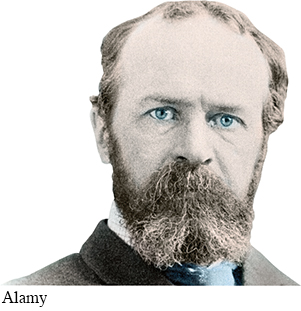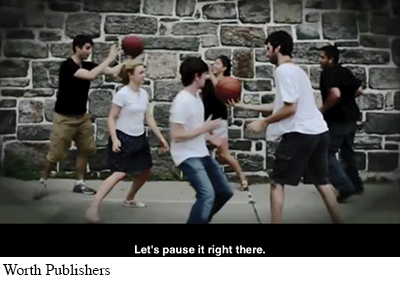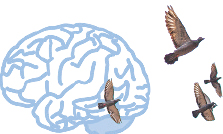INTRODUCTION:
Consciousness
EXPERIENCING THE “PRIVATE I”
KEY THEME
Consciousness refers to your immediate awareness of mental activity, internal sensations, and external stimuli.

KEY QUESTIONS
What did William James mean by the phrase “stream of consciousness”?
What are the functions of consciousness?
How is attention defined, and how do the limitations of attention affect human thought and behavior?
Its nature is difficult to define precisely. For our purposes, we’ll use a simple definition: Consciousness is your immediate awareness of your internal states—
Take a few moments to pay attention to your own experience of consciousness. You’ll notice that the contents of your awareness shift from one moment to the next. Among other activities, your mental experience might include focused attention on this textbook; awareness of internal sensations, such as hunger or a throbbing headache; or planning and active problem-

Consciousness, then, does not appear to itself chopped up in bits. . . . It is nothing jointed; it flows. A “river” or a “stream” are the metaphors by which it is most naturally described. In talking of it hereafter, let us call it the stream of thought, or consciousness, of subjective life.
—William James (1892)
Even though your conscious experience is constantly changing, you don’t experience your personal consciousness as disjointed. Rather, the subjective experience of consciousness has a sense of continuity. This characteristic of consciousness led the influential American psychologist William James (1892) to describe consciousness as a “stream” or “river.” Despite the changing focus of our awareness, our experience of consciousness as an unbroken “stream” helps provide us with a sense of personal identity that has continuity from one day to the next.
Consciousness allows us to integrate past, present, and future behavior, guide future actions, and maintain a stable sense of self (Baumeister & Masicampo, 2010; Baumeister & others, 2011). And, it gives us the ability to plan and execute long-
Our definition of consciousness refers to waking awareness. However, psychologists also study other types of conscious experience, which we’ll consider later in the chapter. But first, we’ll take a closer look at the nature of awareness.
Attention
THE MIND’S SPOTLIGHT
Lost in your thoughts, you don’t notice when your instructor calls on you in class. “Pay attention!” your professor says impatiently.
But what is attention? In reality, you are always “paying attention” to something—just not always the stimuli that you’re supposed to be paying attention to. For example, when your mind “wanders,” you are focusing on your internal environment—
Like consciousness, attention is one of the oldest topics in psychology (Raz, 2009). And, like consciousness, attention is difficult to define precisely.
For our purposes, we’ll define attention as the capacity to selectively focus senses and awareness on particular stimuli or aspects of the environment (Chun & others, 2011; Posner & Rothbart, 2007). Most of the time, we are able to deliberately control our attentional processes, which helps us regulate our thoughts and feelings. For example, we may deliberately turn our attention to a pleasant thought or memory when troubled by a painful memory (Baumeister & Masicampo, 2010; Baumeister & others, 2011).
Everyone knows what attention is. It is the taking possession by the mind, in clear and vivid form, of one out of what seem several simultaneously possible objects or trains of thought. . . . It implies withdrawal from some things in order to deal effectively with others.
—William James (1890)
Psychologists have identified a number of characteristics of attention, some of which have important implications for our daily life. These are:
1. Attention has a limited capacity.
At any given moment we are faced with more information than we can effectively process. We cannot pay attention to all of the sights, sounds, or other sensations in our external environments. Similarly, the range of potential thoughts, memories, or fantasies available to us at any given time is overwhelming. Thus, we focus our attention on the information that is most relevant to our immediate or long-
2. Attention is selective.
Attention is often compared to a spotlight that we shine on particular external stimuli or internal thoughts. Like a spotlight, we focus on certain areas of our experience while ignoring others (Dijksterhuis & Aarts, 2010).
A classic example of the selective nature of attention is the cocktail party effect (Hill & Miller, 2010). If you’re at a crowded, noisy party, you’re literally engulfed in a sea of auditory stimuli. But, you are able to attend to one stream of speech while ignoring others that compete for your attention (Koch & others, 2011).
Although you can monitor multiple streams of information, you can only truly pay attention to one stream of speech at a time. So, at the same party, you are somewhat aware of information that is going on in the background, even though you’re not actively paying attention to it (Raz, 2009). For example, if you hear your name mentioned by someone in a different conversational group, you will probably shift your attention to the other conversation and strain your ears to hear what is being said about you.

3. Attention can be “blind.”
Given the limited, selective nature of attention, you shouldn’t be surprised to learn that we often completely miss what seem to be obvious stimuli in our field of vision or hearing. For example, magicians exploit the limited, selective nature of attention with a strategy called misdirection (Lamont & others, 2010). They deliberately draw the audience’s attention away from the “method,” or secret action, and toward the “effect,” which refers to what the magician wants the audience to perceive (Macknik & others, 2008). To experience a bit of magic firsthand, direct your attention to Figure 4.1.

First, pick one of the six cards below and remember it.
Say its name aloud several times so you won’t forget it. Once you’re sure you’ll remember it, circle one of the eyes in the row above. Then go to page 138.


Think you’re good at paying attention? Try Video Activity: Attention.
Magicians also exploit a basic human tendency known as inattentional blindness, which occurs when we simply don’t notice some significant object or event that is in our clear field of vision (Mack & Rock, 2000). Because we have a limited capacity for attention, the more attention we devote to one task, the less we have for another. Thus, when we are engaged in one task that demands a great deal of our attention, we may fail to notice an event or object, especially if it is unexpected or unusual.
For example, if a clown on a unicycle crossed your path while you were walking across campus, do you think you would notice? Psychologist Ira Hyman enlisted a student to dress up as a clown and slowly unicycle across a busy campus square (Hyman & others, 2010). Researchers later stopped people whose paths had crossed with the unicycling clown and asked them whether they had seen him. Most of the people who were walking alone, in pairs, or who were listening to iPods did notice the clown. However, only one-
We can also experience inattentional deafness (Macdonald & Lavie, 2011). Most of us have been so engrossed in a book or video that we failed to hear a roommate’s question.
Finally, change blindness is also relatively common. Change blindness refers to not noticing when something changes, such as when a friend gets a haircut or shaves his beard (Rosielle & Scaggs, 2008). Were you fooled by the magic trick in Figure 4.1? If so, you can blame change blindness.
The Perils of Multitasking
Multitasking refers to paying attention to two or more sources of stimuli at once—
MYTH SCIENCE
Is it true that multitasking is an efficient way to get things done?
In general, tasks that are very different are less likely to interfere with each other. There is evidence that visual and auditory tasks draw on independent, different attention resources—

Think Like a SCIENTIST
Are you good at working on several tasks at once? Go to LaunchPad: Resources to Think Like a Scientist about Multitasking.

The perils of divided attention are especially obvious when people use cell phones. As demonstrated by the unicycling clown study, using a cell phone seems to absorb a great deal of attentional resources. Partly because cell phone conversations can be so absorbing, they are especially likely to produce inattentional blindness (Chabris & Simons, 2010). One study found that driving was more impaired when drivers were talking on a cell phone than when the same drivers were legally drunk (Strayer & others, 2006). And, it turns out, using a headset or Bluetooth device while driving does not improve safety. It’s the attention devoted to the conversation that is dangerously distracting to drivers (see Baumeister & others, 2011; Drews & others, 2008). In fact, the National Safety Council (2014) found that cell phone use was involved in more than a quarter of motor vehicle crashes in 2012—
Distractions are just one factor that affects the quality of awareness. We’ll begin our exploration of variations in consciousness by looking at the biological rhythms that help determine the nature and quality of our daily conscious experience.